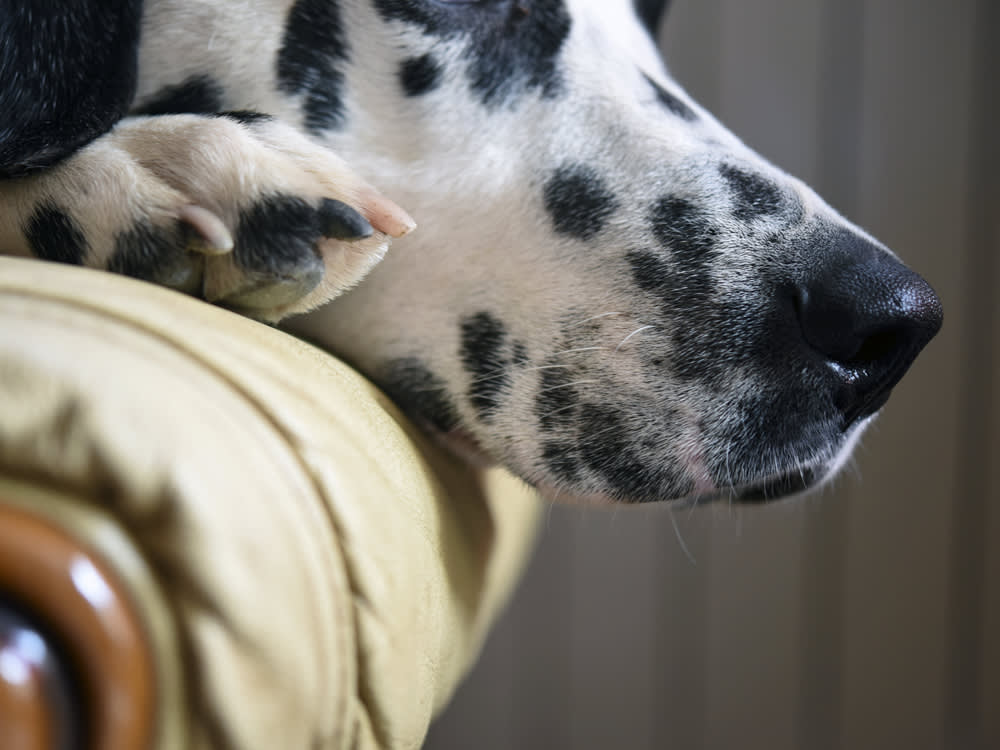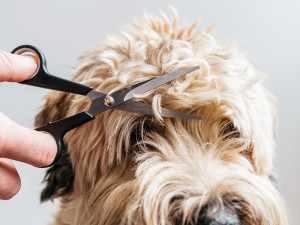What to Do If Your Dog Has a Cracked, Broken, or Torn Nail
A vet explains when you can treat the injury at home — and when it’s best to seek professional help.

share article

Your pet wants you to read our newsletter. (Then give them a treat.)
If your dog suddenly begins limping, take a look at their paw — they might have a cracked, broken, torn, or injured nail. A dog’s broken toenail can be a painful and potentially expensive injury, and it is common in the veterinary ERopens in a new tab.
There are a variety of injuries that can occur to a dog’s nails. Some nails have just a minor crack with some bleeding, while other injuries put a toenail at a 90-degree angle (ouch!). A cracked or broken nail that is bleeding and very painful for your dog should be treated by a vet. That said, not all broken nails require a trip to the ER — you may be able to treat your dog at home, at the very least, so you can wait to see your regular vet in the morning.
So, what should you do if you suspect your dog has a nail injury? Read on to find out.
How can I tell if my dog has a cracked, broken, or torn nail?
You might notice that your dog is limping suddenly on one leg. First, get a good look at the paw — including in between the toes and webbing — to see if the issue is a cut, foxtailopens in a new tab, insect stinger opens in a new tab(or other foreign object), or a broken nail. When doing so, be sure to look closely at the nail bed, as I have seen cracks and injuries in the nail that were actually hidden underneath the fur line, where the base of the nail goes into the toe.
What are the general types of nail injury for dogs?
If it’s a nail injury, determine which type it is. There are three of the most common dog nail injuries:
The dog’s nail has been completely broken off and is bleeding.
The dog’s nail is cracked or broken but is loosely attached.
The dog’s nail is cracked or broken but remains firmly attached.
How can I treat the nail injury in dog at home?
Broken-Off Nail
When the nail is fully broken off, and there’s some mild bleeding, it’s a best-case scenario (if the bleeding continues, though, that may be worrisome). These are the easiest types of nail injuries to treat with a home remedy because you generally only need to apply pressure with a gauze or clean cloth to the nail to stop the bleeding. The key to fix a broken nail is to hold pressure for at least five to 10 minutes with no “peeking to see” if the bleeding has stopped before this time is up.
It’s important to keep your dog calm during this time, as excitement increases blood pressure and works against a good clot forming. If bleeding continues despite applied pressure, you can apply styptic powder (such as Kwik Stop) and resume applying pressure for another five minutes or so. If you do not have styptic powder at home, sometimes a little baking soda can do the trick. If the bleeding continues despite these measures, then I suggest going to the ER.
Loosely Attached Cracked or Broken Nail
If you do happen to find that your dog’s cracked nail is very loose and dangling, then you can attempt to remove it at home. Be sure to have someone help restrain your dog safely while you gently try to remove the nearly broken-off nail with a quick pull motion. Caution: Only attempt removal if the nail is very loose! Think “loose wiggly tooth,” like when you were a kid.
Also, be careful during your inspection or attempt to remove your dog’s loose cracked nail because this can cause a sudden and unpleasant pain sensation in which some dogs may nip or bite in surprise. If your dog is bleeding following the removal, you can then use some gauze, light pressure, and/or Kwik Stopopens in a new tab.
When should I consult a vet?
Firmly Attached Cracked or Broken Nail
These are nails that are cracked, continually painful, may be bleeding, and are still firmly attached. If your dog’s nail is cracked and the quick is exposed, it should be treated by a veterinarian. Treatment for these stubborn injured nails is typically some form of sedation with pain medication followed by cutting off the damaged nail just above the level of the crack.
Sedation is needed because you are cutting through the very thick part of the nail with a live blood vessel and nerve, which is very painful. This is usually followed by styptic powder application and a bandage that is left in place for about 24 hours. The bandage promotes a day of rest so that a solid clot forms and the minor wound does not continue to bleed if it gets bumped on something.
Although these types of injuries require professional care, it is something that can wait to be seen the following day if you are unable to get an immediate appointment with your vet (unless your dog seems to be in extreme painopens in a new tab; in that case, don’t wait).
How can I reduce the risk of infection?
Whenever a toenail breaks in a dog, nail infection becomes a concern. A dog’s feet are in constant contact with the ground, and the quicks of broken nails are open to contamination. Nail bed infections are extremely painful and cause a dog’s toe to become hugely swollen and inflamed.
Cleaning a dog’s nail wound is a good first step in care. Ideally, this would be handled at a vet’s office because they can use medications to make the process less stressful and less painful for your dog. If you’re in a location without convenient veterinary care, there are some steps you can take to help prevent infection and keep the nail wound clean.
If your dog has long hair covering the nail, use clippers (not scissors) to gently trim hair away from the injured nail. Some dogs may not allow this if they are very painful or sensitive about their feet.
Rinse the foot with clean, lukewarm water. Remove any visible dirt and debris.
Use a povidone iodine soak to help kill bacteria. In a plastic or metal bowl, add very small amounts of povidone iodine to lukewarm water until it reaches the color of weak tea. It doesn’t take much iodine. Have your dog stand with their foot in this solution for five to ten minutes. This may temporarily stain the hair of dogs with lighter coats.
Pat the area dry after soaking.
If there is bleeding, apply gentle pressure, styptic powder, flour, or corn starch.
Keep your dog in a clean environment and limit their time outside until the nail is healed. At-home bandaging is not recommended for pet parents because it is easy to make the bandage too tight and cut off blood flow to the foot. Use an e-collar to prevent your dog from licking at the nail constantly. Keep the foot clean and repeat the povidone iodine soaks twice daily until you can see your vet.
How long does it take for a cracked or torn nail to heal?
After the initial trauma is resolved, the first thing many dog parents want to know about their dog’s broken nail is how long it takes to heal. It can take a few days to a couple of weeks for the exposed tissue to be less sensitive. Just like when you smash your fingernail in a door, it takes longer for normal nail to regrow than it does for the sensitivity to resolve.
The average dog’s toenails grow at a rate of 0.7 to 2.1 mm per weekopens in a new tab. The rate of nail growth depends on a variety of factors including the dog’s age, environmental factors, and overall health. In general, you can expect it to take at least six to ten weeks for the nail to regrow to a normal length.
Cracked toenails can have their own set of problems. The weakened, cracked nail will sometimes continue to splinter as the nail regrows and the dog puts pressure on it. If the crack is worsening or not improving, having the nail addressed by a veterinarian is vital. These chronically broken nails can be a source of pain and infection.
Rarely, the nail bed is damaged when a toenail breaks. This can cause the nail to regrow in a weird shape or direction or even not regrow at all. Check your dog’s broken nail at least weekly to make sure it’s regrowing steadily and with a normal appearance.
Can I use styptic powder on my dog’s nail?
Styptic powder contains agents that help stop bleeding from small superficial wounds. This powder is used to stop bleeding when a dog’s nails are broken or cut too short. It should never be placed in a large, deep, or open wound. It can sting when applied, so be cautious when applying it to a fresh wound.
Your vet’s office or local pet supply store may sell styptic powder for you to keep on hand for nail trimming accidents or broken toenails. If you don’t have any on hand, and your dog is bleeding from an injured nail, there are alternatives that most people have around the house. Flour or corn starch can stand in for styptic powder in a pinch. Their texture allows them to pack around a broken nail and help a blood clot form more easily.
How can I prevent nail injuries in my dog?
One of the best ways to prevent a nail injury in your dog is to keep their nails trimmed, because short nails are less likely to tear. You can trim opens in a new tabyour dog’s nails at home if you’re comfortable with that, or have them trimmed at your vet’s office if not. The trick is to trim your dog’s nails as short as possible while avoiding the quick. If your pup is super independent, you can get them a ScratchPadopens in a new tab so they can trim their nails on their own.
FAQs (People Also Ask):
What if the nail is bleeding excessively?
You can control the bleeding by wrapping your dog’s foot in gauze and applying pressure. If the bleeding does not stop in five to ten minutes, apply a styptic powder.
Will my dog need pain relief?
It depends on the extent of the nail break and your dog’s discomfort. Your veterinarian may prescribe pain medication for a few days to keep your dog more comfortable.
Should I try to trim the nail myself?
If your dog’s nail is fully broken off, and there’s some mild bleeding, you can probably trim it at home safely by applying pressure with gauze to stop the bleeding.
References
The Effect of Aging on the Rate of Linear Nail Growthopens in a new tab
Pride and Groom What to Do When Your Dog Breaks Their Nail: A Guide to Proper Careopens in a new tab
Pumpkin Dog Broke A Nail? Here’s What To Doopens in a new tab
Embrace Pet Insurance How to treat a dog’s broken nailopens in a new tab

Dr. Shea Cox, DVM, CVPP, CHPV
Dr. Shea Cox is the founder of BluePearl Pet Hospice and is a global leader in animal hospice and palliative care. With a focus on technology, innovation and education, her efforts are changing the end-of-life landscape in veterinary medicine.

Dr. Bartley Harrison, DVM
Dr. Bartley Harrison, DVM is a small animal veterinarian based in North Carolina who has practiced emergency medicine since graduating from the Texas A&M College of Veterinary Medicine. His primary interest areas include pain management, cardiology, and the treatment of shock.
He is a member of the Veterinary Emergency and Critical Care Society, American Veterinary Medical Association, and American Medical Writers Association. In addition to his clinical work, he writes pet health articles to help provide accurate information for both new and experienced pet parents. When he’s not working, he enjoys cooking, traveling, reading, and going on adventures with his dog.
Related articles
![A woman trimming a dog's nails]() opens in a new tab
opens in a new tabHow to Trim Your Dog’s Nails
Five simple steps for trimming your dog’s nails at home.
![Dog laying his head on owners lap while owner holds his ears.]() opens in a new tab
opens in a new tabDIY Physical Exam Part 2 — How to Check Your Dog for Infections
Veterinarian Dr. Shea Cox on how to assess your dog’s eyes, ears, nose, and mouth.
![bandaging dog's bleeding paw]() opens in a new tab
opens in a new tabHow to Care for Your Bleeding Dog
Don’t freak out—here’s what to do.
![uh-oh kit for dogs]() opens in a new tab
opens in a new tabYou Need This Customizable, Vet-Designed First Aid Kit for Dogs
Just in case.
![Cat enjoying laying on girl's legs and being cuddled]() opens in a new tab
opens in a new tabNew Research Aims to Reduce Cat Stress During Nail Trims
Plus, expert advice on how to trim your cat’s nails at home.







